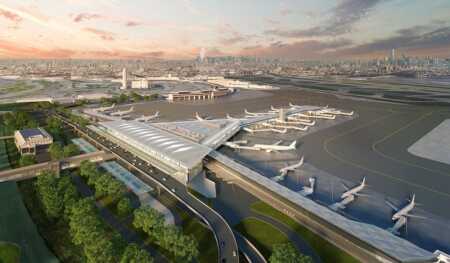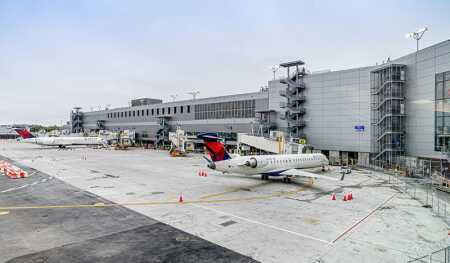New York City’s status as a world city persists not because of but despite the region’s aging airports. Ambitious plans are underway to ensure that these hubs are part of the city’s attraction rather than a distraction. Panelists at a ULI New York event shared some of the plans for the future by the Port Authority of New York and New Jersey to leverage both public and private investments.
Derek Utter, chief development officer at the Port Authority of New York and New Jersey, began by acknowledging the current poor state of the city’s airports. “Everybody knows that our airports in New York have been ranked among the lowest,” he said. “Every time there’s a survey that comes out, no one is surprised to see our airports at the bottom of the pack.” The Port Authority has set out to change this. “We have sweeping ambitions for all of the airports,” he said.
Utter outlined $30 billion in public and private investments at the New York metro area’s three principal airports, which constitutes not only the largest investment in the Port Authority’s history, but also the largest current airport investment in the world, he said.
The LaGuardia Airport project is comprehensive. “We’re actually building a whole new airport,” Utter said, making it the first new airport in the country in 25 years. The entire facility is being demolished in phases and replaced, except for the Marine Air Terminal, which is listed on the National Registry of Historic Places.
The project will cost $8 billion, with three-quarters of the funding originating with private partners, which include LaGuardia Gateway Partners—a consortium composed of Vantage, Skanska, Meridiam, and JLC, a minority-owned investor started by Magic Johnson—and Delta Airlines.
The project will add 2.7 million square feet (251,000 sq m) of passenger space, including a new central hall linking the formerly divided halves of the airport. Two new concourses have already opened, and additional elements will open regularly until the project’s completion in 2022. The redesign has delivered “dramatically more spacious gate areas, with 55-foot [17 m] floor-to-ceiling windows that provide ample light and space,” Utter said, as well as a range of new concessions and passenger amenities.
A new AirTrain service will link the airport to the New York subway system and the Long Island Rail Road; LaGuardia is currently the largest airport on the East Coast without a rail link.
At Newark Liberty International Airport, the Port Authority is replacing the aged Terminal A with a new facility containing over 1 million square feet (93,000 sq m) of space and 33 new concourses. Opening is scheduled for 2022. In addition, the authority has released planning funds for a replacement for the old Terminal B, and the airport’s breakdown-prone AirTrain will also be revamped.
The largest projects will be at John F. Kennedy International Airport, where a large-scale reshuffling of the airport configuration is underway. The authority will demolish three outdated, undersized terminals and use two vacant sites to provide space to build two large, world-class international terminals, he said. The configuration of the airport will shift from six terminals to four much bigger terminals, with an increase in terminal space from 6 million square feet (557,000 sq m) to over 9 million (836,000 sq m).
One new terminal is being constructed by JetBlue and several partners adjacent to its current Terminal 5. A second new terminal, to be the airport’s largest, will be built by a coalition of Lufthansa, Air France, Japan Airlines, Korean Air, and financing partners Carlyle, Ullico, and JLC. Ninety percent of the funding for these new terminals originates in the private sector. Delta is expanding its Terminal 4, while American Airlines is also expanding its terminal to accommodate the arrival of British Airways.
This overhaul will involve the dramatic simplification of the airport’s road network, reducing five loop roads to two and the development of a new ground transportation center, as well as the doubling of the capacity of AirTrain.
Drawing on Best Practices
Best practices applied to the enormous undertaking came from many sources, Utter said. The authority spent a lot of time looking at global airports, identifying the best practices and how to raise New York’s legacy airports to what would be considered world-class status, he said. One source of inspiration was London’s Heathrow Airport.
“A lot of people think about great airports being in China or somewhere in the Middle East where money is no object,” he said. “It’s not the case at all. In fact there are best practices models we can look at with very highly rated terminals in Europe.”
“We have a sort of master class on a monthly basis to talk about lessons learned at LaGuardia Airport,” said Gerard P. Bushell, executive chair of the Terminal 1 development project.
The Port Authority is employing design/build commissions, but, said Utter, “in many cases we try to take it a step further and look at a public/private partnership that involves having an operator run the terminals post-construction.”
Some aspects of the project are unusual, Bushell said. “We have partnered with four world-class airlines that quite candidly do not put capital to work in any other airport across the globe,” he said. “Why do they do it here? Because this is where the action is, this is where the volume is, and this is where they will see the opportunity is.”
The public/private structure presents an opportunity for both partners, he said. “Governments can build. They have the cheapest cost of capital,” he said. “But what I think the state and Port Authority have recognized is we don’t want to offer just that. We want the best and highest value. We want innovation. We want to make sure that we’re delivering infrastructure that will not be obsolete in five to 10 years—that is resilient, that can continue to evolve, that is the bedrock in terms of these public and private initiatives.”
Christina Callahan, deputy general manager at LaGuardia Airport, noted the challenges of building a new airport on top of a fully functioning airport that is growing. A key is ensuring not merely the promise of future high quality, but also delivering it even amid construction. “The customer experience cannot suffer because of a redevelopment program. That’s not an excuse, and we don’t allow that to happen.”
Ensuring high-quality passenger service is in part simply a question of responsive service and aid with direction finding. In addition, the redesigns are adapting to considerable shifts in airport use: many check-ins are occurring long before the passenger arrives at an airline counter.

A rendering of the future John F. Kennedy International Airport, where a large-scale reshuffling of the airport configuration is underway. The configuration of the airport will shift from six terminals to four much bigger terminals, with an increase in terminal space from 6 million square feet (557,000 sq m) to over 9 million (836,000 sq m).
Bushell acknowledged that contemporary expectations make the request that passengers arrive at the airport two hours before flight departure no longer acceptable. “How can we push out information to all of our customers like how long it takes them to get to a gate before they get to the airport to know how to manage their time?” she said.
Benefiting the Community
These projects are focused not only on passengers, but also on the community. Callahan noted that 2,500 construction workers are on site at LaGuardia each day, which requires planning to accommodate their presence with regular airport functions, but also a reminder of a broader community the project aims to serve.
“The other piece of delivering a huge piece of infrastructure to the community is, does the community benefit?” Bushell noted. These airport projects are “creating a pathway for middle-class jobs that pay very well,” he said. “We’re going to have a seamless web of opportunity in terms of how you create jobs.”
Concerted efforts have been made to find local employees and contractors and to ensure representation of minority- and women-owned businesses in the projects. Even such aspects as retail businesses are keyed to providing local benefit: 50 percent of retailers in the new Terminal 1 are to be local.
Thomas J. Grech, president and chief executive officer of the Queens Chamber of Commerce, discussed the many local employers and the work they have found on such projects. He noted that many are small enterprises: 90 percent of the chamber’s members have 10 or fewer employees, he said. Such projects offer them the opportunity to expand and develop capacity.
Francisco Pineda, academic program director and lecturer at Columbia University, observed that the airport redevelopments are not just a discrete series of projects. “We all view it as a regional capacity development for our community,” he said.
The undertaking in multiple ways is a start, not a conclusion, pointing the way to continued innovation, Callahan said. “Just because a new element comes on line doesn’t mean that our job is done,” he said. The living airport calls for constant evolution, but a large amount of that evolution is underway right now in New York.






